Earth Orientation Animations
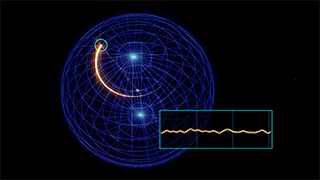
Nutation and Precession
03/01/2013
Nutation and precession are the periodic and long-term motion of the Earth's spin axis in space. The direction of the Earth's axis in space, shown in orange, changes over time with respect to extremely distant objects, such as quasars. When measured with respect to these distant objects, the spin axis appears to trace a circle in the celestial sphere over a long period of time (approximately 26,000 years). This precession motion is driven by the gravity of the Moon and the Sun acting on the Earth's equatorial bulge. However, because the Moon orbits the Earth once a month, in a tilted, elliptical orbit, the spin axis also undergoes a smaller set of nutation motions on much shorter time scales (days to years). This is why the line traced by the spin axis appears "bumpy" when viewed up close.
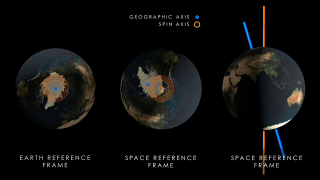
Polar Motion - Three Views
03/01/2013
Polar motion describes the motion of the Earth's spin axis (shown in orange) with respect to the geographic north and south poles (shown in blue). Over time, the geographic poles appear to spin away from the spin axis when viewed from space and then back again. Viewed from the perspective of someone on Earth, the spin axis instead appears to spiral away from the geographic poles and then spiral back. The motion of the spin pole with respect to the geographic poles fixed to the Earth's crust is called polar motion.
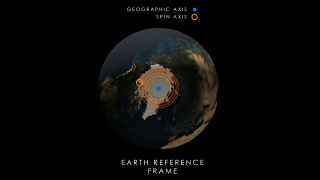
Polar Motion - Overhead View, Earth Reference Frame
03/01/2013
This animation demonstrates polar motion from an overhead perspective. It is also depicted from the frame of reference of someone standing on the Earth. From this perspective, the spin axis appears to rotate away from the geographic axis.
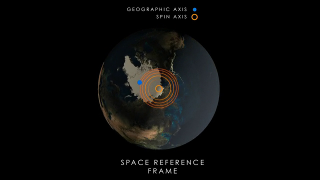
Polar Motion - Overhead View, Space Reference Frame
03/01/2013
This animation demonstrates polar motion from an overhead perspective. It is also depicted from the frame of reference of someone in space above the Earth. From this perspective, the geographic axis appears to rotate away from the spin axis.
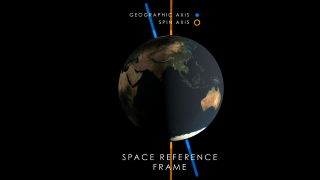
Polar Motion - Side View, Space Reference Frame
03/01/2013
This animation demonstrates polar motion from a side-view perspective. It is also depicted from the frame of reference of someone in space above the Earth. From this perspective, the geographic axis appears to rotate away from the spin axis.
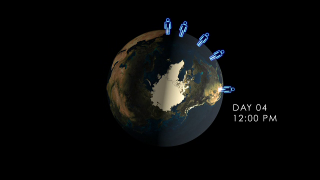
UT1
03/01/2013
UT1 describes the non-uniform daily rotation of the Earth. At any particular time, the rotation angle of the Earth differs from what would be predicted if the length of day were exactly 24 hours. So, if you were to measure the rotation angle at exactly 12:00 P.M. for many days in a row, you would find that your measurements would vary from day to day, with the overall trend showing that the rotation angle gradually decreases over time. After a long period of time, you would have to add one second to the day, called a "leap second", to compensate for this.


